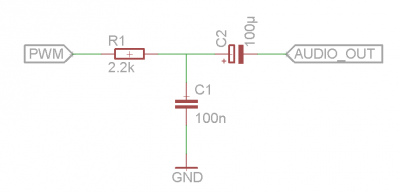Auduino: Difference between revisions
(github link) |
No edit summary |
||
| Line 36: | Line 36: | ||
Maybe that could be added as an option as well. | Maybe that could be added as an option as well. | ||
=== CV Inputs === | === CV Inputs (for sequencers) === | ||
CV Inputs are now done using 3.5mm jacks with integrated switches. They are placed between the potentiometers and the analog inputs of the Arduino. When a plug is inserted, the potentiometer gets disconnected from that particular input. | |||
Next steps are to add some input over-voltage protection in the form of zener diodes, and maybe a possibility to use 0-10V CV. | |||
A gate input would be great as well. | |||
==== Adapt the Scales to 1V/Octave ==== | ==== Adapt the Scales to 1V/Octave ==== | ||
| Line 43: | Line 47: | ||
=== Line Level Output === | === Line Level Output === | ||
By default, the Auduino outputs a PWM-signal between 0 and 5V. | By default, the Auduino outputs a PWM-signal between 0 and 5V. We want to adapt this down to line level, which according to the web is between -0.5V and 0.5V. So it needs some kind of filter and pad on the output. We put together something simple with only 3 parts. See the circuit below | ||
{| | |||
| [[File:Arduino PWM Audio Filter.png|400px|thumb|PWM to Line level audio filter]] | |||
|} | |||
=== Headphone out === | === Headphone out === | ||
Revision as of 11:28, 3 August 2014
| Auduino Release status: experimental [box doku] | |
|---|---|
| Description | Simple Arduino based synthesizer |
| Author(s) | tiefpunkt |
| Download | https://github.com/tiefpunkt/Auduino |
The Auduino is a small synthesizer, based on the Arduino. The only external components required are 5 potentiometers, and something to output the sound, such as a small speaker, or a headphone jack.
Hacks
Modify the scale
By default, the Auduino uses a pentatonic scale. That can be changed in the source. An external switch to change the scale during runtime would be awesome.
Below are the options, only one is executed during runtime.
// Smooth frequency mapping //syncPhaseInc = mapPhaseInc(analogRead(SYNC_CONTROL)) / 4; // Stepped mapping to MIDI notes: C, Db, D, Eb, E, F... //syncPhaseInc = mapMidi(analogRead(SYNC_CONTROL)); // Stepped pentatonic mapping: D, E, G, A, B syncPhaseInc = mapPentatonic(analogRead(SYNC_CONTROL));
Adding some if-clauses, dependend on digitial inputs might be a decent solution.
Delay
Here's an example on using a ring buffer as a delay: http://rcarduino.blogspot.de/2012/11/auduino-with-delay.html
Maybe that could be added as an option as well.
CV Inputs (for sequencers)
CV Inputs are now done using 3.5mm jacks with integrated switches. They are placed between the potentiometers and the analog inputs of the Arduino. When a plug is inserted, the potentiometer gets disconnected from that particular input.
Next steps are to add some input over-voltage protection in the form of zener diodes, and maybe a possibility to use 0-10V CV.
A gate input would be great as well.
Adapt the Scales to 1V/Octave
On "old" analog synth hardware, 0-10V CV was used, with 1V/Octave. Not sure if the current scale reflects that, but it would be cool if it did, otherwise it might be wise to adjust this. However, in our case it would have to be 0.5 V/Octave
Line Level Output
By default, the Auduino outputs a PWM-signal between 0 and 5V. We want to adapt this down to line level, which according to the web is between -0.5V and 0.5V. So it needs some kind of filter and pad on the output. We put together something simple with only 3 parts. See the circuit below
Headphone out
Add a headphone output to the line output.
Links
- Audoino Homepage
- Audoino Step Synthesizer (includes a good explaination of what's actually happening inside the synth)

